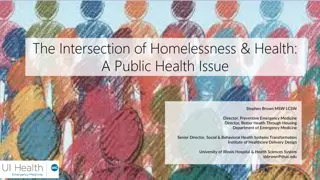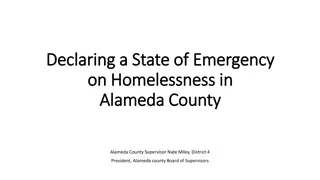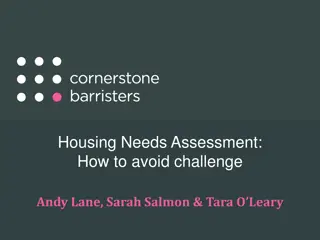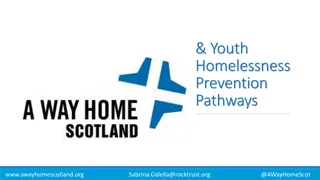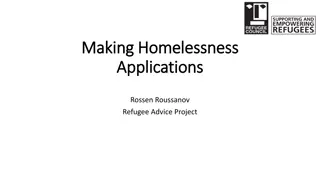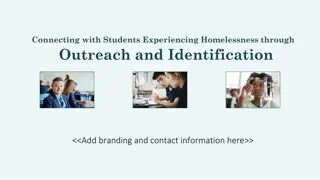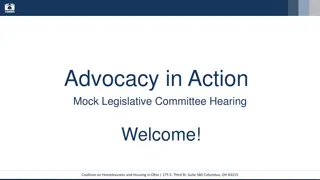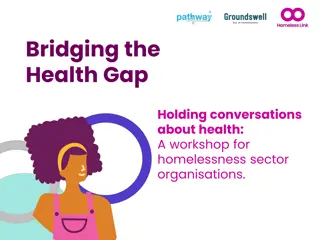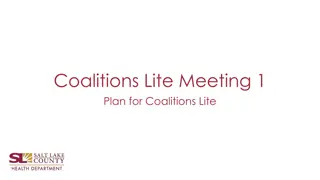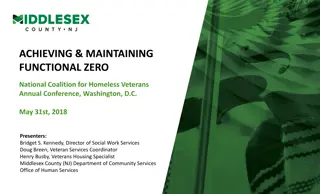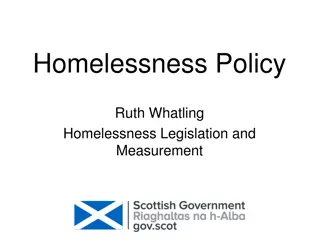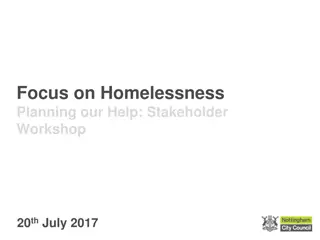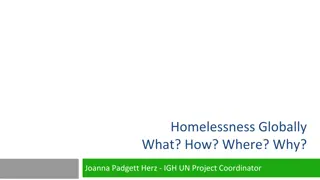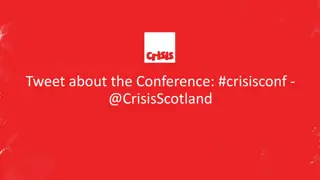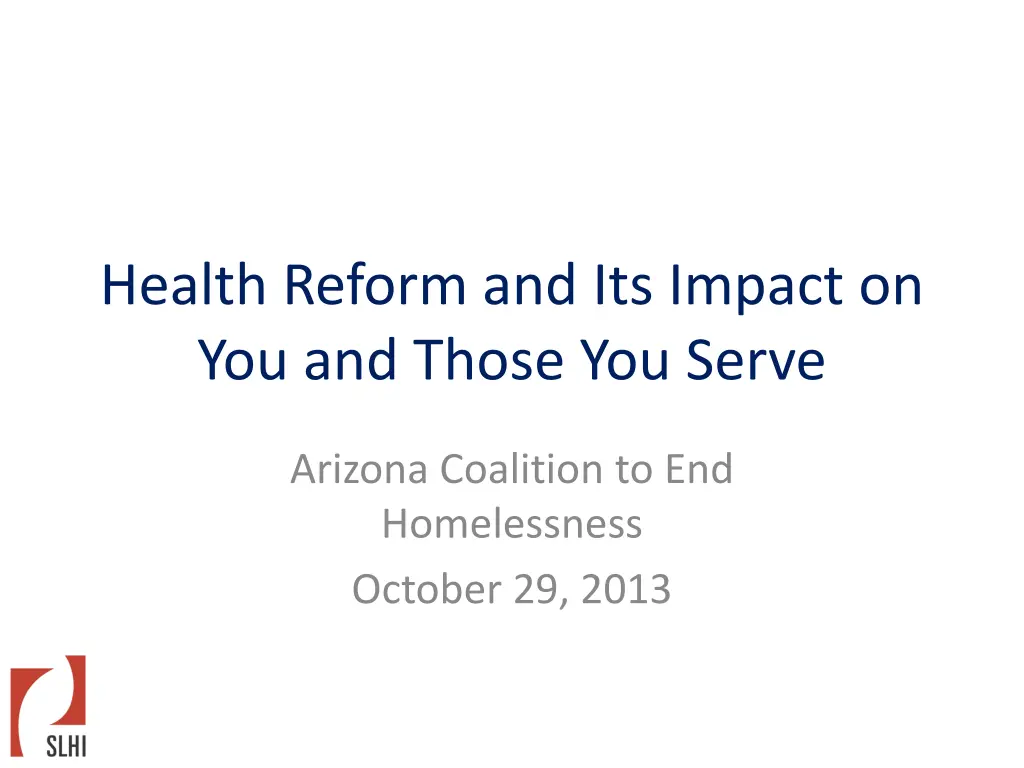
Impact of Health Reform on Arizona's Homeless Population
Learn about the pressing need for health reform in Arizona, particularly concerning the homeless population. Discover the challenges faced, the importance of expanding Medicaid, and key principles guiding reform efforts.
Download Presentation

Please find below an Image/Link to download the presentation.
The content on the website is provided AS IS for your information and personal use only. It may not be sold, licensed, or shared on other websites without obtaining consent from the author. If you encounter any issues during the download, it is possible that the publisher has removed the file from their server.
You are allowed to download the files provided on this website for personal or commercial use, subject to the condition that they are used lawfully. All files are the property of their respective owners.
The content on the website is provided AS IS for your information and personal use only. It may not be sold, licensed, or shared on other websites without obtaining consent from the author.
E N D
Presentation Transcript
Health Reform and Its Impact on You and Those You Serve Arizona Coalition to End Homelessness October 29, 2013
Why Is Reform Needed? Nearly 1-in-5 Arizonans lack health coverage Medical debt significant cause of financial insecurity Growth in healthcare costs are unsustainable, crowding out other public spending, personal income
Why Is Reform Needed? Americans are getting far too little bang for our healthcare dollar We have a sick care system, not a healthcare system Status quo is unacceptable
Health Reform and the Homeless Seventy percent of those experiencing homelessness are uninsured Those who are homeless often experience chronic health conditions, including behavioral health issues Medicaid coverage has been limited for many among the homeless population in recent years People who are homeless are often high medical care utilizers, driving up healthcare costs for us all
Health Reform Access and Coverage Quality Cost 5
Principles for Reform Encouraging healthy behaviors Improving access to early, preventive care Changing how healthcare is delivered Managing the care of high utilizers Changing the incentives Eliminating waste
Coverage Expansion Employer-based coverage Medicaid The Exchange 7
Medicaid Expansion Over 300,000 Arizonans could benefit Supported by the Governor, passed by the Legislature Approximately 60 percent of voters support restoration or expansion Restores coverage to childless adults
Medicaid Expansion Increases eligibility up to 133 percent of the federal poverty level (approximately 15,000/year for an individual) Eligibility screening began October 1st Coverage begins on January 1, 2014
Health E Arizona Plus Online application for AHCCCS as well as programs such as TANF and SNAP Began mid-October, 2013 Consolidation, update of existing state eligibility systems
Health E Arizona Plus Access to federal data hub, making eligibility determinations easier Renewals less frequent, easier More affordable options for community providers to participate Connection to Marketplace
Improvements to Coverage Requires many health plans to offer ten essential health benefits Provides broader access to behavioral health and substance abuse services Prohibits many insurance plans from charging cost sharing for preventive services
Improvements to Coverage Prevents discrimination in pricing based on pre- existing conditions Those who have self-insured or grandfathered plans will not benefit from essential benefits, elimination of cost-sharing Those on traditional Medicaid may not benefit from essential benefits in some instances
Essential Benefits Emergency services Hospitalization Maternity and newborn care Mental health and substance use disorder services Prescription drugs; Rehabilitative and habilitative services and devices Laboratory services Preventive and wellness services Chronic disease management Pediatric services, including oral and vision care
Essential Benefits Arizona picked state employee plan, administered by United Health Care, as benchmark www.cms.gov/CCIIO/Resources/Data- Resources/Downloads/arizona-ehb- benchmark-plan.pdf
The Marketplace Online site for individuals and small businesses to compare and purchase health coverage Intended to simplify and structure health insurance choices for individuals, families and small businesses Exclusive mechanism for receiving federal subsidies and plans with cost-sharing limits
The Marketplace Open enrollment began October 1 Open enrollment will occur through the end of March 1.3 million Arizonans predicted to eventually receive coverage through the marketplace
Plan Levels of Coverage Level of Coverage Plan Pays on Average Enrollees Pay on Average (In addition to the monthly plan premiums) Bronze 60% 40% Silver 70% 30% Gold 80% 20% Platinum 90% 10%
Premium Subsidies Tax credit is advanceable or refundable Eligibility is based on Projected household income and family size 100 400% FPL ($23,550 -$94,200 for a family of four in 2013) Obtaining qualified coverage through the marketplace Ineligible for government-sponsored coverage, affordable-sponsored insurance, or certain other minimum essential coverage
Cost Sharing Reduction Eligibility for reduced cost sharing is based on incomes at or below 250% of FPL ($58,875 annually for a family of four in 2013) Receiving the new premium tax credit Enrolling in a marketplace silver-level plan No cost sharing for members of Tribes
Individual Mandate Beginning in 2014, most people must have health coverage or pay a fee when you file your tax return Some people may qualify for an exemption
Cover Arizona Builds off of the successful outreach efforts for the Pre-Existing Conditions Insurance Pool More than 600 members Two goals: Maximize enrollment of individuals and families in the new insurance marketplace and Medicaid Identify and assess outreach efforts so that we can build on our successes
How Cover Arizona is Organizing By Demographics By Geography By Strategy
Enrollment Assistance Navigators Certified Application Counselors Brokers Health E Arizona Plus Assisters
Resources healthcare.gov www.cuidadodesalud.gov marketplace.cms.gov 1-800-318-2596 (open 24/7, 150+ languages) www.healthearizonaplus.gov 1 855 HEA-plus coveraz.org
Optimizing Coverage Among Those Experiencing Homelessness Having staff dedicated to outreach, education, and enrollment assistance Building community partnerships to assist with outreach and enrollment activities Educating individuals about the specific benefits of coverage and the overall enrollment process
Optimizing Coverage Among Those Experiencing Homelessness Providing direct hands-on, one-on-one assistance through each step of the enrollment process Assisting in obtaining documentation by helping to fill out paperwork, going with or providing transportation to the offices, and covering the cost of replacing documents Storing copies or originals of documents in client file to keep them safe and secure
Optimizing Coverage Among Those Experiencing Homelessness Providing transportation and accompanying individuals on visits to the eligibility office Maintaining contact over time to assist in the renewal of coverage Engaging providers to remind individuals about steps needed to complete enrollment during patient visits Educating consumers about how to use their benefits, access health care
Improving Quality, Lowering Costs Opportunities to move forward on: Coordination of care, integration Community-based care Chronic disease management Primary care Prevention Incentivizing value-based health care
Changes in Care Delivery Accountable Care Organizations and other models aimed at rewarding outcomes Penalties for inappropriate hospital readmissions Movement towards medical home model where care is coordinated Integration of acute care and behavioral healthcare
Opportunities To serve an essential community provider for a health plan To partner in helping hospitals manage inappropriate hospital readmissions To become a member of a provider networks for those caring for persons with behavioral health needs To partner with a federally qualified health clinic to provide care coordination

